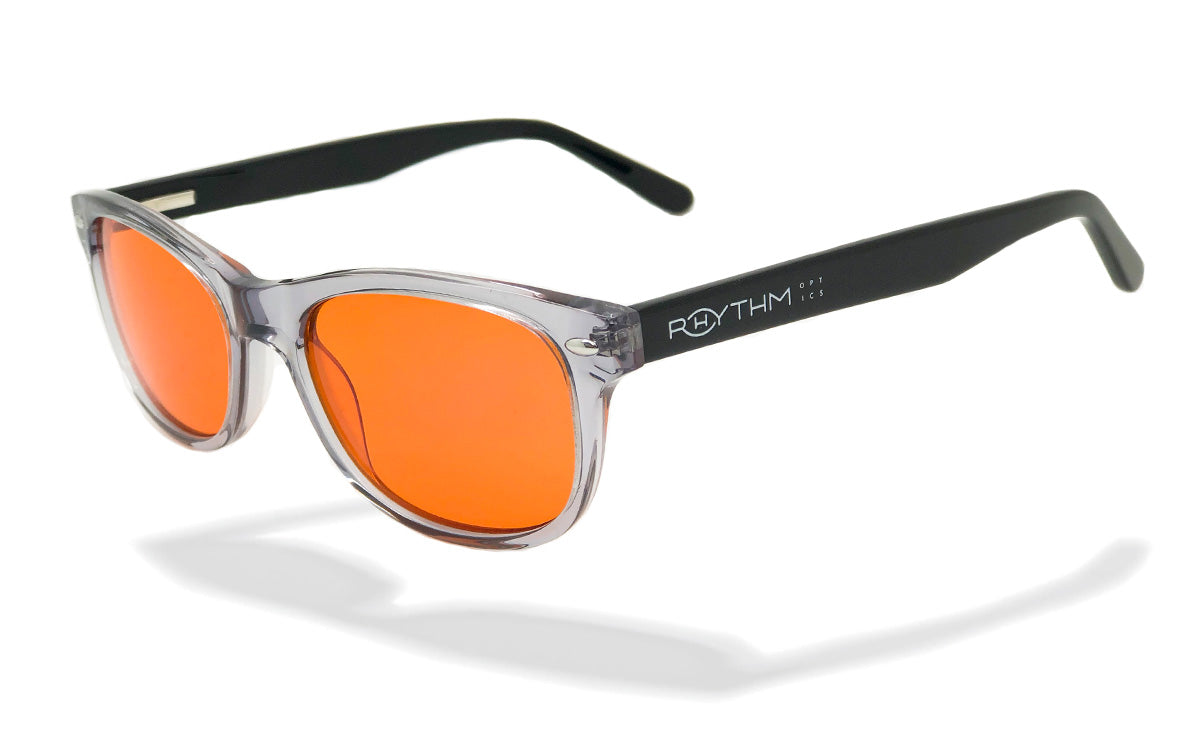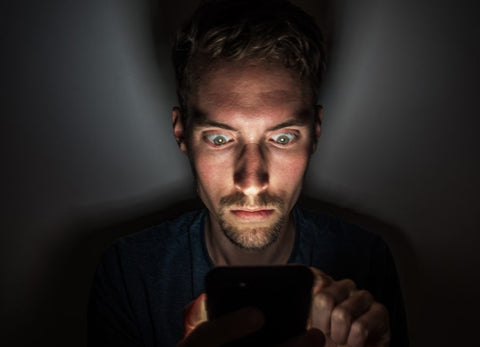About Blue Light and your Health
CliffsNotes version for the non-nerds
Light Environment > Detected by Eyes > Interpreted by Master Clock > Sleep & Healing Hormone Melatonin Release > Circadian Rhythm > Mitochondrial Health > Cell Death > Organ failure >Overall Health/Disease
Blue light is a high-energy light wave. Artificial Blue light, from screens and lights - not the sun - is highly stimulating and when detected by the eye, especially after sunset, prevents proper sleep. Your sleep/wake cycle is linked to your Circadian Rhythm. Your Circadian Rhythm is linked to your Mitochondria, which produces energy in your cells. When your mitochondria dysfunction, which they do if your sleep is bad, cells die off, organs begin to fail, and you are prone to all manner of serious diseases. Oh and kids under 10 years old absorb up to 60% more blue light because their eyes aren't fully developed.
This is a far bigger issue than "digital eye strain" and clear lensed "computer glasses" only block 25-50% of blue light, that in the lower 400-450nm range. This will only help protect the eyes themselves from damage and reduce a bit of eye strain using devices during the day.
If they don't block blue in the 450-500nm range, then after sundown they wont help optimize your circadian rhythm or support your health at a cellular level. But, they do look attractive on Instagram! Only you can decide if "Likes" are more important than your health...
Solution: Get natural sunlight in the early morning to create Melatonin, the hormone responsible for sleep and healing. Wear Rhythm Optics Eyewear designed to protect your eyes from 100% of the blue light from screens and LED lighting, especially in the evening. Doing so will help you release Melatonin early enough to get quality sleep, allowing your body to restore, recover, and heal.
A deeper dive for the science geeks
What is Blue Light?
Light is made up of electromagnetic particles that travel in waves. These waves emit energy, and range in length and strength. The length of the waves is measured in nanometers (nm). Some are visible to the human eye, and some are invisible.
Blue light is a colour in the visible lightspectrum, along with green, yellow, orange and red. Blue Light falls within the 400-500nm range
The shorter the wavelength; the higher the energy. Blue light is the shortest in the visible spectrum and of the highest energy. In the lower half of its range (400-450nm) it is known for causing physical eye damage such as macular degeneration. In the upper half of its range (450-500nm) it is known for disrupting Melatonin hormones affecting sleep and health in general.
Every wavelength is represented by a different colour, and is grouped into the following categories: gamma rays, x-rays, ultraviolet (UV) rays which sit to one side of the visible light spectrum- Violet, Blue, Green, Yellow, Red, then followed by...infrared light, microwaves and radio waves. Together these wavelengths make up the electromagnetic spectrum.
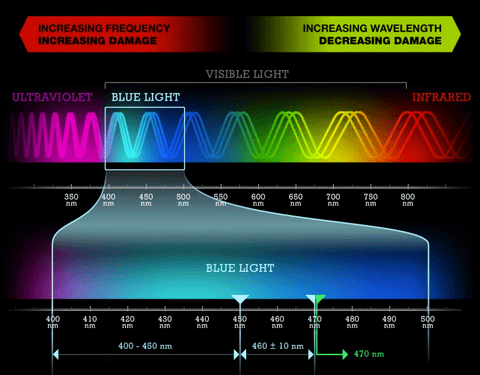
Blue Light in nature
In nature, there is Blue light present from the sun, but it is only and always delivered with the rest of the spectrum and balanced out by a proportionately large amount of Red. It’s proportion also varies over the course of the day from sunrise to noon, to sunset. In modern artificial lighting blue is predominant, delivered in spikes, and diminished of the full spectrum.
In the image below you can see how the blue spike in the bright white LED (bottom left) is higher than even midday sun, out of balance across the spectrum and very low in red.
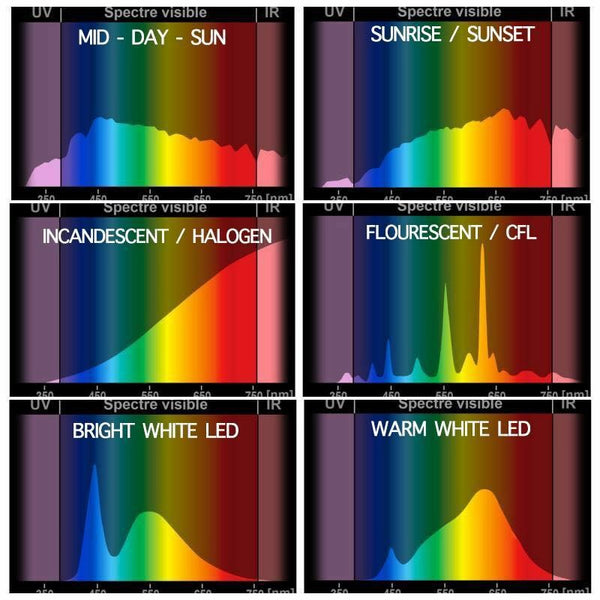
Artificial Blue Light
The invention of artificial lighting is a relatively recent one in the timeline of human evolution. For millions of years, we evolved with the sun as our major source of light, and we spent our evenings in relative darkness, with a fire maybe, and later candles and lanterns at best...
It’s only in the last 100-130 years since electricity we’ve been able to illuminate our evenings with artificial lighting, only the last 50 or so years we’ve had television screens to stare at, and only the last decade we’ve had LED screens on computers, tablets and smartphones. And we now spend an average of 11.1 hours a day looking at them, increasing every year. Early lighting was Incandescent, and as you can see on the chart above, was low in blue, and high in red, giving off a "warm" light. Now, we’ve also “updated” lighting in our homes to high energy blue light wave LED’s in the name of energy efficiency. This last decade is only a blip on 6 million years of evolution timeline.
Earth is now lit up like a Christmas tree at night.

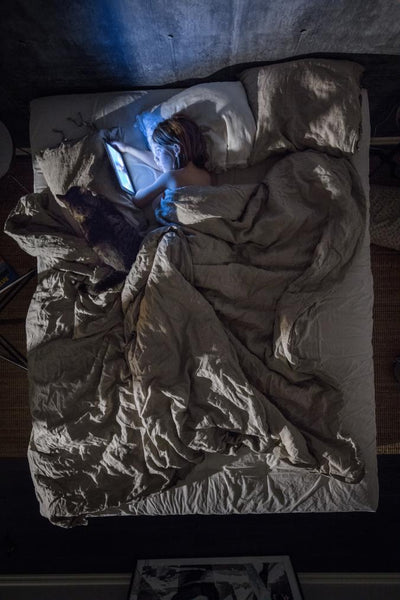
This light is entirely "Alien" to our biology...we were NOT designed for this, and with this environmental change being within such a short period, we have not evolved or adapted to this either.
So what price do we pay?
Sure, access to this easy light affords us all sorts of benefits in terms of comfort, productivity and progress.
But what are we trading off for it? Turns out, it’s our health.
I’m going to show you how the dots connect first, then explain them.
Light Environment > Detected by Eyes > Interpreted by Master Clock > Melatonin Release > Circadian Rhythm > Mitochondrial Health > Overall Health/Disease
Our eyes as light sensors
Within our eyes there are photoreceptors known as the Retinal Ganglion Cells, yet they have nothing to do with our vision. They contain Melanopsin and detect varying light spectrums and send information to the Suprachiasmatic Nucleus (SCN) or our “master clock”. This in turn signals to our Pineal Gland to release the hormone Melatonin. There are many other “clock genes” within our body controlling the timing of metabolic processes in our organs. The timing of all this sets what’s known as our Circadian Rhythm. You’ve probably heard of it, but it was only recently fully understood.
The Nobel Prize in Physiology or Medicine 2017 was awarded jointly to Jeffrey C. Hall, Michael Rosbash and Michael W. Young"for their discoveries of molecular mechanisms controlling the circadian rhythm".
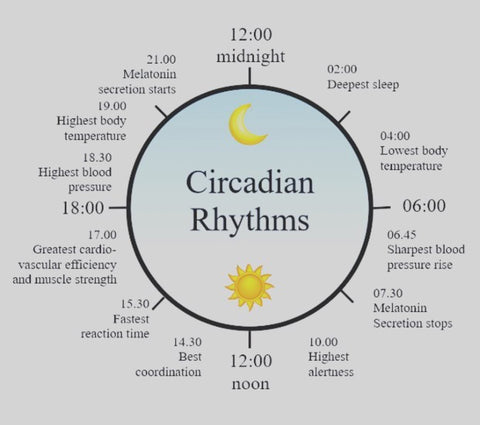
Circadian Rhythm and Mitochondria
Circadian Rhythm has also now been linked to how our Mitochondria function. Mitochondria are the energy producer within our cells, sustaining life by producing ATP, regulating cellular metabolism and responsible for supporting organ function. They are in high concentration in the heart, brain, lungs and muscles. Mitochondria are entirely inherited from our Mother. They are also our “2nd DNA” known as Mitochondrial DNA (mtDNA). Unlike Nucleus DNA (nDNA) which are genetic, mtDNA are highly changeable, constantly adapting and even mutating based on the environment they sense. Now think back for a moment to how different our light environment is in the last 10years, the last 100 years, and then to the thousands or millions of years before this change.... Do you think it's sensing some strange anomalies?
Your Circadian Rhythm is integral to determining when and how much energy your mitochondria can supply.
"The time of day determines the design of the mitochondrial network, and this, in turn, influences the cells' energy capacity," explains study leader Professor Anne Eckert from the University of Basel's Transfaculty Research Platform Molecular and Cognitive Neurosciences MCN.
So when your Circadian Rhythm is disordered by the wrong light at the wrong time, your mitochondria become dysfunctional. When your mitochondria become dysfunctional, your major organs - the brain, heart, lungs - begin to dysfunction and break down. When mitochondria fail, cells die. When multiple cells deaths occurs, organ failure follows.
Mitochondria and Disease
Mitochondrial diseases can affect almost any part of the body, including the cells of the brain, nerves, muscles, kidneys, heart, liver, eyes, ears or pancreas.Mitochondrial dysfunction has been linked to a laundry list of diseases including:
- Alzheimers
- Autism
- Cancers
- Cardiovascular disease
- Dementia
- Depression
- Diabetes
- Gastrointestinal disorders
- Increased risk of infections
- Kidney & Liver Disease
- Neurological issues such as migraines, seizures and strokes
- Obesity
- Thyroid problems
- Respiratory problems
So how does all that relate to Blue Light again?
Because blue light suppresses Melatonin by up to 90% by tricking your clock genes into thinking it is high noon regardless of the time of day. If you are exposed to it after sundown, especially from looking at screens until late at night, it leaves you “wired” and even though you eventually go to sleep out of exhaustion, the sleep is not restorative. It takes at least a few hours of darkness before going to sleep for optimal sleep to be had. Proper sleep is when your cells go to work at cleaning house, rejuvenating, and healing. If you deny yourself this fundamental requirement, the above listed problems are likely headed your way!
This is a far bigger issue than "digital eye strain" and clear lensed "computer glasses" only block 25-50% of blue light, that in the lower 400-450nm range. This will only help protect the eyes themselves from damage and reduce a bit of eye strain using devices during the day.
If they don't block blue in the 450-500nm range, then after sundown they wont help optimize your circadian rhythm or support your health at a cellular level. But, they do look attractive on Instagram! Only you can decide if "Likes" are more important than your health...
Also, up to 60% more blue light is absorbed by the eyes of children under 10 years old because the crystalline lens and cornea in their un-developed eyes are still largely transparent and overexposed to light. There is good reason Steve Jobs' own kids were not allowed to use his Apple products... If you do let them use these modern day pacifier/baby sitting devices, think about protecting them from this.

So what can I do about it?
There are 2 parts to optimizing your light environment:
- Get up at sunrise and get outside for 15-45mins to receive full spectrum sunlight signals into the eye. Melatonin is created in the morning to be released in the evening.
- Protect your eyes from artificial blue spectrum light, especially after the sun sets.
There is no magic product that can replace the sun, so #1 is up to you to get up and get out there. Get sun in your eyes and on your skin, especially in the AM. And one of the best ways to manage #2 is with Rhythm Optics blue light blocking glasses are designed to block 100% the harmful spectrum of artificial blue light from hitting the eyes, especially important in the PM.



